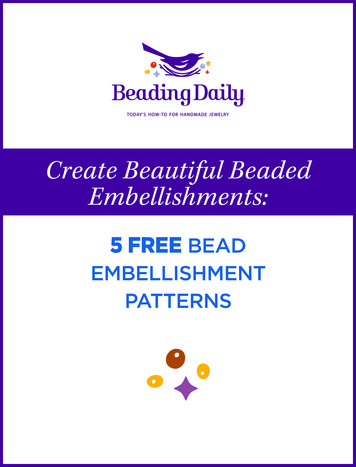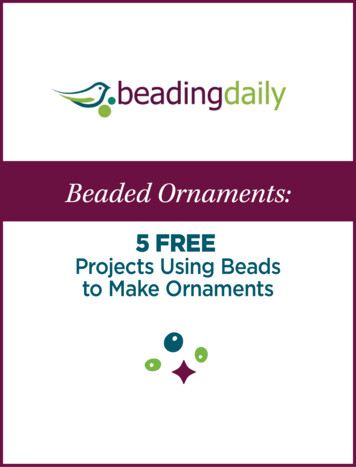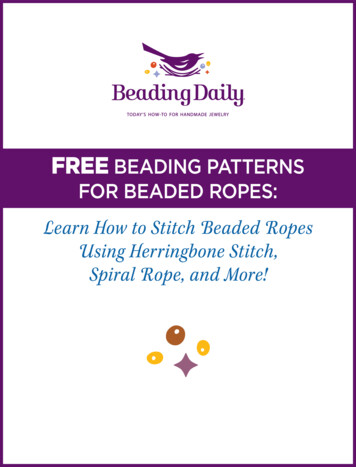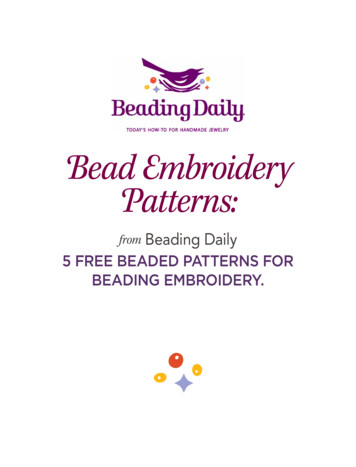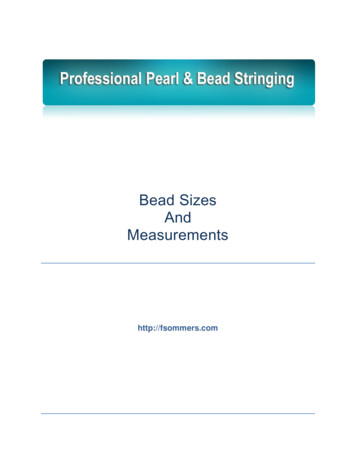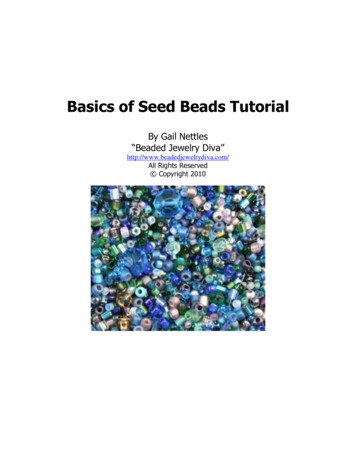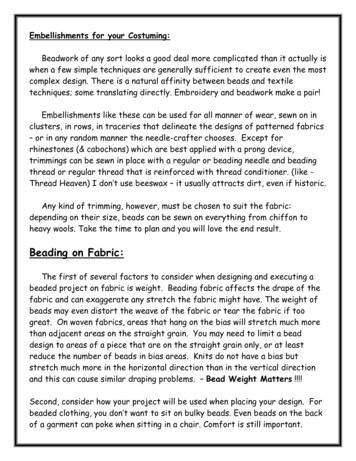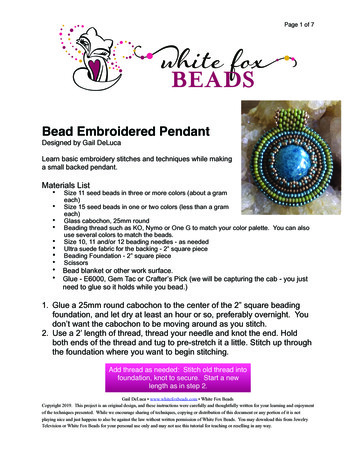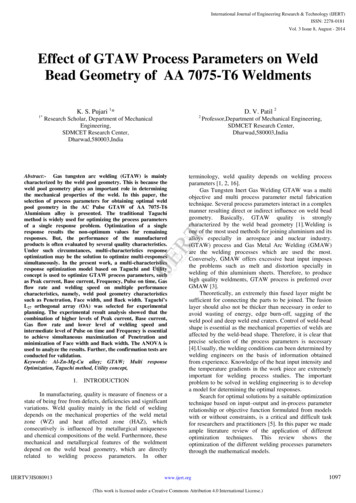
Transcription
Free BeadCraft PatternsBeaded Flowers, BeadedOrnaments, Pony Bead Patterns,and More Bead Crafts
Free Bead Craft PatternsBeaded Flowers, Beaded Ornaments,Pony Bead Patterns, and More Bead CraftsSpangled Island BottleSki Sweater Matchbox CoverDutch Spiral Basketby inga hunter p. 1by Susan Swanson p. 2by Alison Eastman p. 3Beaded Bug BoxesBeaded Easter EggHerringbone Weave Coasterby Ramona Finocchiaro p. 6Contentsbeadworkonlinetechnique nettingby Yulia Crystal Papakina p. 9by Beadwork Design Team p. 11Marguerite Daisy PinSnowflake Ornamentby Arlene Baker p. 6by Robin Cowart p. 6Snowflake OrnamentRobin CowartThis festive snowflake has many uses: decorate your holiday packages with it, dangle iton a small suction cup with a hook in a window, or hang it on a holiday tree.ii
Free Bead Craft PatternsBeaded Flowers, Beaded Ornaments,Pony Bead Patterns, and More Bead CraftsBead crafts have been around for hundreds of years. Thefirst bead crafts were probably related to adorning clothingwith thousands of tiny beads, but artists soon discovered thatthey could use beads to craft other items such as baskets, jars,and ornaments. There are many wonderful examples of beadcrafts in museums around the world!But beaded crafts don’t have to be big and elaborate. In fact,you probably have everything you need right now to sit down andstart creating a piece of beaded art. Turn your trash into treasure by adding some beads! And who hasn’t admired those lovelybeaded ornaments that turn up during the winter holidays?We’ve assembled a collection of eight bead craft projectsjust to give you a taste of what those beads can do! We allknow that beads can be used to make beautiful jewelry, butwith a little imagination, beads can be used to craft all sortsof items. Dig through your recycling and find an old glass bottle,then turn it into a piece of beaded home decor by making IngaHunter’s Spangled Island Bottle. The beads and sequins willbrighten up any room. Don’t throw away that empty matchbox! Susan Swanson’sSki Sweater Matchbox Cover fits like a glove so you can usethat old matchbox to store your favorite tiny bead treasures. Make a decorative basket out of beads with Alison Eastman’sDutch Spiral Basket. It’s perfect for a sunny porch or yourfavorite kitchen table. Take an ordinary mesh bug box and turn it into a work ofbead art with Ramona Finocchiaro’s Beaded Bug Boxes. Theseare definitely NOT for the kids! Learn some basic French beaded flower techniques with ArleneBaker’s Marguerite Daisy Pin. Beaded flowers are beautiful at anytime of the year, and this one can be made in any color for any occasion. Learn a new beading stitch and whip up a set of easy Herringbone Coasters using pony beads for your next party. Choose brightcolors of pony beads to make your party even more festive! Thepony beads make it easy to learn a new beading stitch! Imagine how delightful a basket full of Yulia Crystal Papakina’sBeaded Easter Eggs would be—no refrigeration required! Hidethem in the backyard for your favorite egg hunter on Easter morning or tuck them into a little Easter basket with some jelly beans. What would the winter holidays be without a flurry of Snowflake Ornaments by Robin Cowart? Sparkling seed beads make thesebeaded ornaments an essential part of your holiday decorations, andthey make great beaded gift tags for your holiday packages.Yes, beads have the power to turn the ordinary into the extraordinary—with just a little bit of thread, wire, and patience, you canturn an everyday object into a carefully crafted piece of bead art.Now that you’ve seen just what you can do with bead crafts, take alook around and see where you can add some more beads to yourlife! You never know where the beads will show up next!Bead Happy,Jennifer VanBenschoten, Beading Daily editorFree Bead Craft Patternseditor, beadingdaily JENNIFER VANBENSCHOTENdesigner oceana garceau / photography JOE COCA, ANN SWANSONProjects and information are for inspiration and personal use only. BeadingDaily, Beadwork, and Stringing do not recommend, approve, or endorse any of the advertisers, products, services, orviews advertised in this publication. Nor do BeadingDaily, Beadwork, or Stringing evaluate the advertisers’ claims in any way. You should, therefore, use your own judgment in evaluating theadvertisers, products, services, and views advertised in BeadingDaily, Beadwork, and Stringing.iii
Spangled Island BottleMaterials6mm flat sequins, in two greens,gold, blue, and iridescent blackSize 11 red, green, and black seedbeadsGold metallic Delica beadsSmall glass Tabasco bottleDark-colored knit fabric (T-shirtfabric works well)Size A Silamide beading threadNotionsSmall sturdy pillowTwo size 9 milliner’s needlesFabric marking pencilI’m a mixed media artist from a seriesof islands: Jamaica, my family’s home;England, where I was born; and Australia,that enormous island at the bottom ofthe world, where I live. I first saw theexhibition of Haitian flags that inspiredme to do sequined bottles at the University of California, Los Angeles, in1996 while I was on my way to see myfamily in Jamaica. Of course I had seenphotographs before, but the reality is somuch more—the brilliance just doesn’ttranslate. The flags were so beautiful!So colorful! With such texture—anddone with a skill that I will never beable to equal. I came away dazzled.One of the characteristics of Haitianflags which is not so clear in photographs is the two layers of color. Youhave the sequin layer underneath, andthe bead layer riding on top, so thatyou can play with colors in a complex,sophisticated manner. I have beenusing beads and sequins since I was sixteen, but I had never thought of usingthem in quite this way.I had beads and embroidery gear inmy suitcase, and when I arrived inJamaica I was so enthusiastic aboutwhat I had seen, that my artist cousinJasmine Thomas suggested that we tryout the technique as soon as possible.Trouble was, no sequins! We searchedKingston, and finally found some whiteones that we dyed blue, red, and purplewith my hair dye. Although the dye istemporary when used on hair, it didcolor the sequins. I have some sequinsleft and the color is still there after sixyears, so it certainly won’t fade, but itisn’t exactly perfect—unless you actuallywant unevenly colored dull spangles.But it was all we had, and I did my first piece,a combination of sequins and embroidery. It looks a bit amateurish now, butI thought it was wonderful at the time.Inga HunterLater, in Australia, I saw anotherexhibition of Haitian art, and boughtmy first flag, one by Eviland Lalanne—abit faded but absolutely gorgeous! Anda constant source of technical inspiration for me. At the exhibition I sawmany libation bottles and nearly turnedmyself inside out trying to see how theywere done; finally I decided to work itout for myself. In my defense, I felt, andstill feel, that I share a similar background with the people of Haiti, and amable to do this work without dishonor.One of the advantages of havingunknown African ancestors is that youcan go along with your intuition.It wasn’t easy. I figured that the bottleshad to be covered with cloth, and thesequins stitched on, so I covered a littlewine bottle with old T-shirt fabric andbegan. Two bottles later, I had encountered a whole heap of difficulties, and Iwas hooked. Since then I have madedozens of sequined bottles, and nowthat I have made most of the commonmistakes, I feel that I can pass the technique on to others.Note: One square inch of spanglingwith these sizes uses 36 beads andsequins. The quantities will depend onthe size of your bottle. These are thebead and sequin sizes I used, but youcan vary the sizes at will and the bottlewill still work out. It won’t be wrong,just different. Spangling is not an exactscience, which is one reason I like it—improvisation is both possible and easy.Step 1: Remove the label from the bottle. Stretch the fabric to cover the bottleand stitch it tightly in place. If you leaveit too loose it will be hard to stitch thesequins evenly. Try to keep the seamsflat. You may or may not cover the base.If the finished bottle will be standing,More wonderful beadwork projects are available at shop.beadingdaily.com/jewelryprojects 2011 Interweave Press LLC. Not to be reprinted. All rights reserved.page 1
Step 2: Roughly mark the design on thefabric with the fabric marker. Thedrawing will be covered up, so youdon’t have to be neat. For this bottle,mark two lines around the circumference, dividing the bottle into threeworking areas. On my bottle the middlearea is 1½" wide.Step 3: Anchor your thread securely inthe fabric at the bottom of the bottle.Begin to spangle (see “Stitches,” page84) using the gold beads and goldsequins. Position each sequin so that itoverlaps half the previous sequin. Workfrom the bottom edge of the bottle,around and around, moving up untilyou reach your marked line, whichshould be three rounds of sequins. Varythe look of the sequins by working arow or two with a different color of beads.SpanglingWeave your thread to the second markedline and work gold sequins and beadsto approximately six rows from the topof the bottle, leaving the very top to bedone later. You now have a spacebetween two lots of gold.Divide the middle section evenly into fourwide vertical stripes and mark the fabric. Halve the stripes to mark rectangles. Leave one sequin width from thegold so you can insert another colorlater, and stitch alternating sets ofgreen sequins held down with greenbeads and black sequins held downwith black beads. Work up until youhave reached the halfway mark, aboutfour rows. To make a subtle designchange, stitch alternate rows of sequinsin the two different greens in the greenarea, holding them down with the oneshade of green bead. Once you reachthe halfway mark, change colors.Where you had green sequins helddown with green beads, change to blacksequins held down with green beads.Where you had black sequins helddown with black beads, change to greensequins held down with black beads.The result will give you alternatingsquares of green and black underneath,with stripes of green and black over thetop—an interesting characteristic common in the Haitian technique. Work upuntil you are one sequin row short ofthe gold. Note: You get a better result byworking around the bottle than working in blocks of color.Step 5: Move your needle to the spaceon the body of the bottle at the bottomof the green and black oblongs. Add around of blue sequins held down withthree red beads. Skip the third bead andpass back through the other two beadsinto the sequin. Repeat this round atthe second space at the top of the colored oblongs.Step 6: At the top of the bottle, stitch around of red beads with gold sequins, around of black beads with black sequins,a round of green beads with greensequins, and cover the top with goldsequins stitched with one gold andthree red beads. These beads make little red dreadlock fringes that finish thewhole thing off.Inga Hunter is a mixed-media arist and writerwho lives in Leura (near Sydney), Australia.Step 4: Bead the base by beginning atthe outside edge; stitch one round ofgreen beads with green sequins, oneround of black beads with blacksequins, a round of red beads with goldsequins, and finish with a center of redbeads with blue sequins.Tips Like all beading, spangling is a matterof patience and rhythm. Thread can often catch aroundsequins. Experienced spanglers cantell this has happened by the feel ofthe thread, perhaps from the tensionin the thread. If you find your threadis caught, go back and restitch thesequins. Broken threads are always a problem,as in any beadwork. And in the sameway, you don’t want your work to fallapart. To be sure it doesn’t, be awareof frayed threads. Fraying can easilyhappen when you’re dealing with thesharp edges of sequins. If your sequins are overlapping thewrong way, take a needle and flipthem over or under, however you wantthem to lie.Woman of Three IslandsPhoto by Inga Hunterglue card stock or leather to the bottomfor a base and don’t spangle there. If thebottle will hang, spangle the base. Thesame applies to the top opening—youcan cover it up or leave it open depending on the purpose of the finished bottle. Use the pillow to rest the bottle onas you work.More wonderful beadwork projects are available at shop.beadingdaily.com/jewelryprojects 2011 Interweave Press LLC. Not to be reprinted. All rights reserved.page 2
Ski Sweater Matchbox CoverSue SwansonMaterialsDelicas in matte cream white #352(W) and matte powder blue #760 (B)1 8" doll buttonsMatchboxBlue paintSize D Nymo beading threadNotionsSize 10 or 12 beading needlesThread HeavenScissorsAleene’s Premium Bond Glass andBead Slick Surface AdhesiveI love to light candles all over the house but I can neverfind the matches. So I designed these covers so that matchboxesare pretty enough to leave out on a table. The match safes used inthe 1800s inspired the idea. When matches were invented, theywere highly flammable and were kept in little metal boxesso that they could be carried around. The metal was decoratedwith intricate tooling. The English called them vesta boxes.More wonderful beadwork projects are available at shop.beadingdaily.com/jewelryprojects 2011 Interweave Press LLC. Not to be reprinted. All rights reserved.page 3
After I made my first matchboxcover, I ran across a felt-covered matchbox at a garage sale for 10 . It remindedme of the kitschy matchbox covers thatcrafters made in the 1960s. I think thatmy beaded version is much more elegant. In addition to looking pretty on atable, your covered matchbox can becarried in a beading kit for knot-melting .Step 1: Paint the matchbox cover andthe ends of the drawer. Place the cover’sseam on the bottom.Step 2: Using a 4' length of conditionedthread and leaving a 6" tail, string a tension bead (see “Stitches,’’ page 80).Rows 1 and 2: String 5B, 3W, 17B, 3W,15B for a total count of 43 beads.Row 3: Hold the string of beads in your lefthand on top of your index finger. String1B and pass through the first B. Workthe row in odd-count flat peyote stitch(see “Stitches,’’ page 80) using 7B, 1W,9B, 1W, 3B. Pass through the first B ofRow 1 to prepare to begin Row 4.Row 4: Work 1B, 1W, 2B, 1W, 6B, 1W, 2B,1W, 6B. Remove the tension bead andsew the thread tail through several beads.Row 5: Work 6B, 1W, 1B, 1W, 1B, 1W, 5B,1W, 1B, 1W, 1B, 1W. End the row witha turnaround (Figure 1). In odd-countpeyote, every other row ends in a turnaround.Row 6: Work 1B, 1W, 2B, 1W, 6B, 1W,2B, 1W, 6B.Row 7: Work 6B, 5W, 5B, 5W, 1B.Row 8: Work 2B, 2W, 2B, 1W, 2B, 1W,2B, 2W, 2B, 1W, 2B, 1W, 1B.Row 9: Work 1B, 2W, 1B, 2W, 2B, 1W,2B, 2W, 1B, 2W, 2B, 1W, 3B.Row 10: Work 2B, 2W, 2B, 1W, 2B, 1W,2B, 2W, 2B, 1W, 2B, 1W, 1B.Row 11: Work 3B, 1W, 2B, 5W, 2B, 1W,2B, 5W, 1B.Row 12: Work 1B, 1W, 2B, 1W, 2B, 2W,2B, 1W, 2B, 1W, 2B, 2W, 2B.Figure 1More wonderful beadwork projects are available at shop.beadingdaily.com/jewelryprojects 2011 Interweave Press LLC. Not to be reprinted. All rights reserved.page 4
Row 13: Work 3B, 1W, 2B, 1W, 1B, 1W,1B, 1W, 2B, 1W, 2B, 1W, 1B, 1W, 1B,1W, 1B.Row 14: Work 1B, 1W, 2B, 1W, 1B, 1W,2B, 1W, 1B, 1W, 2B, 1W, 1B, 1W, 2B,1W, 1B.Row 15: Work 1B, 1W, 1B, 1W, 1B, 1W,2B, 1W, 2B, 1W, 1B, 1W, 1B, 1W, 2B,1W, 3B.Row 16: Work 2B, 2W, 2B, 1W, 2B, 1W,2B, 2W, 2B, 1W, 2B, 1W, 1B.Row 17: Work 1B, 5W, 2B, 1W, 2B, 5W,2B, 1W, 3B.Row 18: Work 1B, 1W, 2B, 1W, 2B, 2W,2B, 1W, 2B, 1W, 2B, 2W, 2B.Row 19: Work 3B, 1W, 2B, 2W, 1B, 2W,2B, 1W, 2B, 2W, 1B, 2W, 1B.Row 20: Work 1B, 1W, 2B, 1W, 2B, 2W,2B, 1W, 2B, 1W, 2B, 2W, 2B.Row 21: Work 1B, 5W, 2B, 1W, 2B, 5W,2B, 1W, 3B.Row 22: Work 2B, 2W, 2B, 1W, 2B, 1W,2B, 2W, 2B, 1W, 2B, 1W, 1B.Row 23: Work 1B, 1W, 1B, 1W, 1B, 1W,2B, 1W, 2B, 1W, 1B, 1W, 1B, 1W, 2B,1W, 3B.Row 24: Work 1B, 1W, 2B, 1W, 1B, 1W,2B, 1W, 1B, 1W, 2B, 1W, 1B, 1W, 2B,1W, 1B.Row 25: Work 3B, 1W, 2B, 1W, 1B, 1W,1B, 1W, 2B, 1W, 2B, 1W, 1B, 1W, 1B,1W, 1B.Row 26: Work 1B, 1W, 2B, 1W, 2B, 2W,2B, 1W, 2B, 1W, 2B, 2W, 2B.Row 27: Work 3B, 1W, 2B, 5W, 2B, 1W,2B, 5W, 1B.Row 28: Work 2B, 2W, 2B, 1W, 2B, 1W,2B, 2W, 2B, 1W, 2B, 1W, 1B.Row 29: Work 1B, 2W, 1B, 2W, 2B, 1W,2B, 2W, 1B, 2W, 2B, 1W, 3B.Row 30: Work 2B, 2W, 2B, 1W, 2B, 1W,2B, 2W, 2B, 1W, 2B, 1W, 1B.Rows 31–90: Repeat Rows 11–30 threetimes.Rows 91–100: Repeat Rows 11–20 once.Row 101: Work 1B, 5W, 5B, 5W, 6B.Row 102: Work 6B, 1W, 2B, 1W, 6B, 1W,2B, 1W, 1B.Row 103: Work 1B, 1W, 1B, 1W, 1B, 1W,5B, 1W, 1B, 1W, 1B, 1W, 6B.Row 104: Work 6B, 1W, 2B, 1W, 6B, 1W,2B, 1W, 1B.Row 105: Work 3B, 1W, 9B, 1W, 8B.Row 106: Work 7B, 2W, 8B, 2W, 2B.Row 107: Work 3B, 1W, 9B, 1W, 8B.Step 3: Glue the beadwork to the matchbox like a book cover, leaving the strikerstrip exposed on one side. Glue the buttonsalong one edge for a decorative trim.When the matches are gone, refill the boxor insert a new drawer. If the strikerstrip wears out, just cut out a new oneand glue it on the box. Also, you canremove the beadwork by soaking thematchbook in water for a minute. Thenyou can glue the beadwork to a new boxSue Swanson is a bead artist and teacher fromWoodbury, Minnesota. She is a member ofthe Upper Midwest Bead Society. Contact Sueat SwansonMN4@aol.com.More wonderful beadwork projects are available at shop.beadingdaily.com/jewelryprojects 2011 Interweave Press LLC. Not to be reprinted. All rights reserved.page 5
Dutch Spiral BasketA llis o n E ast m a nMore wonderful beadwork projects are available at shop.beadingdaily.com/jewelryprojects 2011 Interweave Press LLC. Not to be reprinted. All rights reserved.page 6
Materials5 gr size 3 Czech bugle beads5 gr size 11 Czech seed beads A(contrasting color to bugles)5 gr size 11 Czech seed beads B(same color as bugles)Size O beading threadStep 2: *String 1 bugle bead and 1 A andpass through the first seed bead of thenext set (Figure 2). Repeat from * forthe desired height of your basket; thesesamples have seven bugle beads in eachvertical row.Step 4: String 3 B and 1 A. Pass throughthe next A. Repeat eight times.Step 5: String 2 B and 1 A. Pass throughthe next A. Repeat eight times.Step 6: String 1 B and 1 A. Pass throughthe next A. Repeat eight times.NotionsThread conditionerSize 12 beading needleGlue or clear nail polishScissorsStep 7: String 1 A. Pass through the nextA. Repeat eight times.Figure 2I developed this basket while working on a Dutch spiral bracelet. I thoughtthat the stitch would lend itself well toa bag. So I set about making a Dutchspiral bag. A wonderful thing happenedhalfway through. I looked down at mypartially finished bag and saw the cutest ring basket! It was the perfect size tohold earrings and rings on top of thedresser. This project can be made withany number of combinations. Forinstance, you can use large bugle beads,or you can make the basket monochromatic, or make each row a differentcolor. Fringe can even be added to thetop. The variations are really endlessand the project is quick enough for youto try them all.Step 8: String 1 A and pass through thenext A. Pass through the next A withoutadding another bead. Pull tight. Repeatthree times.Step 3: String 4 B and 1 A. Pass throughthe next seed bead (Figure 3). Repeateight times around the basket.Step 9: String 1 A. Pass through the next2 A. Repeat two times around the basket.Step 10: Pass through the last 3 Aadded, tie and glue the thread, and trimclose to work.Allison Eastman has been beading for closeto ten years. Over the last several years, shehas turned to sharing her knowledge of theart through teaching and designing beadingkits. To reach her regarding this project, or forthis beading kit and others, go towww.wonderlandbeadworks.net.Figure 3Step 1: Using a yard of conditionedthread, string 2 A and 1 bugle bead.Repeat eight times. Tie into a circle sothat the beads are snug, but not taut(Figure 1). Pass through the first seed bead.Figure 1More wonderful beadwork projects are available at shop.beadingdaily.com/jewelryprojects 2011 Interweave Press LLC. Not to be reprinted. All rights reserved.page 7
Beadweaving on Fiberglass ScreenR a m o n a F i n o cchi a r oMore wonderful beadwork projects are available at shop.beadingdaily.com/jewelryprojects 2011 Interweave Press LLC. Not to be reprinted. All rights reserved.page 8
explore this fascinating technique.Who knows? Given enough time andbeads, maybe a beaded window or doorscreen? A parade float? Happy beading!MaterialsOne wooden bug box12" piece of fiberglass screen15 seed beads (approx. 240 beadsper square inch)Size B beading thread in color tocomplement beads1 1 4 yards gimp or braidSmall brass hasp (optional)One piece of 9" 12" plastic canvasPaint or stain (optional)notionsSize 10 beading needlesHammerScrewdriverIndelible markerGlueSmall nailsMy experience with bead weavingon fiberglass screen began several yearsago when I was looking for a techniqueto make strong and flexible panels for alampshade. I found that 15 seed beadsfit in the mesh holes of ordinary fiberglass window screening and could besecured by adapting the sewing techniqueof loom bead weaving. The screening isvery durable and can be cut and draped,then glued or sewn to almost any surface. The possibilities of this techniqueare endless. Since my first lampshade, Ihave made jewelry, purses, pictures,ornaments, and even garment insertions.Depending on the type of bead you use,the finished work resembles stainedglass (transparent beads) or mosaic(opaque beads).I graphed my first designs on regularsquare graph paper. This is all right insome cases, but since the size 15 Miyuki rocaille bead is essentially rectangular, measuring 1.15 mm in thedirection of the thread and 1.55 mmwide, I created my own graph paper byphotocopying the screen and enlargingthe copy.I hope this article will inspire you tooriginal creations. I am continuing toStep 1: Beg by disassembling the bugbox. Unscrew the handle and removethe doorknob if you are going toreplace it with the decorative hasp.Remove the twill tape covering theedges of the screen mesh and removethe screen. You probably won’t be ableto salvage this screen, because it willprobably tear when you remove it.In making my own screen for thebox, I like to work with two pieces ofmesh, rather than one long continuouspiece; these are easier to handle, thereare fewer beads to count for each row,and the handle will hide the gapbetween the two pieces. For each piece,measure from the center of the screw holeon the top down to the base, about 5½.Measure the width of the box,almost to the edge, which will be about6". Cut two pieces of the screen a littlebigger than your measurements toallow an edge to grab onto as you bead.Remember to check the orientation ofthe screen so that it matches the directionof the rectangular beads.Step 2: To determine the actual amountof screen you will be beading, lay thecut piece of screen up against the box.You will need about ⅜" of the screen forthe margins, sides, top, and bottom.The part you will be beading will be justone row more on each side to cover theedges of the box. Count the screenholes from top to bottom. Mark theborders of your piece of screen with anindelible marking pen. Choose anydesign your heart desires. Many of mydesigns come from Dover books. Youcan graph any design on regular graphpaper or, for less distortion, on a photocopy of the screen mesh.Step 3: Using 1½ yards of thread, tie it tothe intersection of the mesh at a corner,one intersection before the first bead,with the thread and needle below themesh. Following your graph pattern,string the first row of beads. Note:Count and recount! If you pick up anextra bead or two you may be able toget rid of them by smashing them withneedle-nose-pliers.PT the mesh intersection before thelast bead at the bottom of the row. Withthe thread held taut, force the beadsone by one into the holes of the mesh.Size 15 beads vary considerably, butmost should pop right into the meshholes. Once the first several beads arein their holes in the mesh, carefully PBTthe beads on top of the mesh. Continuethrough all the beads on the row, takingcare that the thread is over the intersection of each mesh to insure that allthe beads stay in place. PBT the meshwhere you began. Carefully pull thethread taut so it is smooth and evenbetween all the beads. Rep until you’vecompleted the needed number of vertical rows. Tie thread ends to the mesh.At this point, you may wish to paintor stain the box to complement yourbeaded design.ReinforcingStep 4: Cut the plastic canvas right atthe outside edges of the box. Center thebeaded sections on the canvas and sewthem in place. Nail the pieces to thebox, taking care not to hammer thebeadwork. Once the pieces are nailed, measure, cut, and glue the gimp or decorative braid all around to cover thenailed edges. You will need one continuous piece for the front curved partand another for the back curved part;glue the final piece of trim all aroundthe lower edge. Reattach the handle.Ramona Finocchiaro is a longtime resident ofLas Vegas, Nevada, where she is a memberof the local Fiber Arts Guild. She enjoysspinning, weaving, and knitting in addition tobeading.More wonderful beadwork projects are available at shop.beadingdaily.com/jewelryprojects 2011 Interweave Press LLC. Not to be reprinted. All rights reserved.page 9
Beaded Easter EggY u lia C r ystal Papa k i n aMaterialsSize 11 seed beads orDelicas in main and accentcolors(A and B)Size 1 cut bugle or hex beads101 freshwater pearls, crystals, or any 6–8mm beadsWooden eggHeavy beading thread orFireline 6lb testNotionsSize 10 or 12 beading needlesScissorsFinished Size 3"highTurn an ordinary wooden egg into something extraordinary!Weave freshwater pearls, bugles, hexes, and seed beads into arich-looking netting that will dress up your egg and make it thetreasure everyone wants in their Easter basket this year. Or useseveral to create an unforgettable centerpiece for the holiday table.More wonderful beadwork projects are available at shop.beadingdaily.com/jewelryprojects 2011 Interweave Press LLC. Not to be reprinted. All rights reserved.page 10
Figure 1Step 1: Using 11 2 yd of thread, string 3A andpass back through the first bead leaving a 4"tail. * String 1A and pass back through the lastbead strung. Repeat from * to make a twobead-wide strip to wrap tightly around themiddle of the egg (Figure 1). Stitch the ends ofthe strip together, tie a knot with the tailthread, and exit from the bottom of the band.Step 2: String 3A, 1B, and 3A. Skipping 2beads on the band, pass up through the thirdand down through the fourth beads juststrung. Repeat around the band (Figure 2).Exit through the first 4 beads of this round.Figure 2Step 3: String 1A, 1 pearl, and 1A. Passthrough the next B of the previous round(Figure 3). Repeat around the egg, keeping thethread tight.Figure 3Step 4: Exiting a B of the first round of Step 1,string 3A, 1B, and 3A. Pass through the nextB. Repeat around. Exit through the first 4beads of this round.Step 5: String 1A, 1 hex, and 1A. Pass throughthe next B of the previous round (Figure 4).Repeat around the egg, keeping the thread tight.Step 6: Repeat Steps 4, 3, 4, 5, 4, 3, 4, 5, etc.down this end of the egg. As the shape tapers,reduce the number of pearls between the netting. Toward the base, string 1 or 2 seed beadsin place of a pearl, or every other pearl,depending on the size of the egg. When youFigure 4More wonderful beadwork projects are available at shop.beadingdaily.com/jewelryprojects 2011 Interweave Press LLC. Not to be reprinted. All rights reserved.page 11
near the base, work a final netted row.Exit from a point bead on one of thenets. Do not secure the thread yet.Step 7: Begin a new thread on the otherend of the egg. Repeat from Step 2,decreasing the number of pearls aroundthe egg. You may sometimes need towork a net over two gaps of accentbeads.Step 8: Return to your thread at the bottom of the egg. String enough beads toreach the point of the next net and passthrough it. Repeat around and cinchtight to pull the netting into a circle overthe bottom of the egg. If necessary tohold the circle tight, string beads tocross to the other side of the circle andpass through a few beads of the circle.Repeat around the circle adding spokesof beads (Figure 5). Pull the thread tight,weave through several beads of theupper rows, secure your thread, andtrim close to work.Step 9: Return to the top of the egg.Continue netting to the top, decreasingto about 5 pearls with seed beads on thenets between them. Finish with a tightcircle, passing through the points ofeach net (Figure 6). String a pearl andpass through the opposite side of thecircle. Repeat twice, making sure thethread is tight. Secure your thread andtrim close to the work.Figure 5Figure 6Yulia Crystal was born and raised in theUkraine, and now lives in Austrialia whereshe hopes to maintain a small beaded jewelry business. She’s started beading as a child,and has been beading constantly over the lastten years. Her favorite medium is seed beads,although she has started incorporating gemstones into her work. See Yulia’s work at http://yuliacrystal.com.RESOURCE Wooden egg: Any large craft store.More wonderful beadwork projects are available at shop.beadingdaily.com/jewelryprojects 2011 Interweave Press LLC. Not to be reprinted. All rights reserved.page 12
Herringbone Weave CoasterB ea d w o r k Desig n T ea mMaterials5 oz. size 5 white ponybeads2 oz. size 5 black ponybeads2 oz. size 5 gunmetalpony beadsBlack Nymo “D” threadNotionsSize 12 beading needleScissorsHerringbone StitchBegin with a foundation row of evencount ladder stitch. String 2 beads, passdown through the second-to-last beadin the ladder, and up through the nextbead. String 2 beads, pass down thenext bead and then up through the following. Repeat to the end of the row.To end the row, pass back through thelast bead strung. To begin the next row,string 2 beads and pass down throug
Free Bead Craft Patterns Beaded Flowers, Beaded Ornaments, Pony Bead Patterns, and More Bead Crafts Snowflake Ornament Robin Cowart This festive snowflake has many uses: decorate your holiday packages with it, dangle it on a small suction cup with a hook in a window, or hang it on a holiday tree. technique netting BEADWORK online 1 of 3
